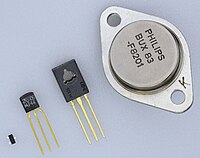
Photo from wikipedia
The channel conduction in 4H-SiC metal–oxide–semiconductor field effect transistors (MOSFETs) are highly impacted by charge trapping and scattering at the interface. Even though nitridation reduces the interface trap density, scattering… Click to show full abstract
The channel conduction in 4H-SiC metal–oxide–semiconductor field effect transistors (MOSFETs) are highly impacted by charge trapping and scattering at the interface. Even though nitridation reduces the interface trap density, scattering still plays a crucial role in increasing the channel resistance in these transistors. In this work, the dominant scattering mechanisms are distinguished for inversion layer electrons and holes using temperature and body-bias-dependent Hall measurements on nitrided lateral 4H-SiC MOSFETs. The effect of the transverse electric field (Eeff) on carrier mobility is analyzed under strong inversion condition where surface roughness scattering becomes prevalent. Power law dependencies of the electron and hole Hall mobility for surface roughness scattering are determined to be Eeff−1.8 and Eeff−2.4, respectively, analogous to those of silicon MOSFETs. Moreover, for n-channel MOSFETs, the effect of phonon scattering is observed at zero body bias, whereas in p-channel MOSFETs, it is observed only under negative body biases. Along with the identification of regimes governed by different scattering mechanisms, these results highlight the importance of the selection of substrate doping and of Eeff in controlling the value of channel mobility in 4H-SiC MOSFETs.
Journal Title: Materials
Year Published: 2022
Link to full text (if available)
Share on Social Media: Sign Up to like & get
recommendations!